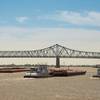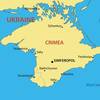Joint Safety Alert: DPS Failure on Vessels
USCG, BSEE issue joint safety alert regarding Dynamic Positioning System Failures
Discussion: This Joint Safety Alert addresses a dynamic positioning (DP) incident on a vessel resulting in a loss of position while conducting a critical Outer Continental Shelf (OCS) activity. An equipment failure, an operational error and multiple failure modes not identified in the vessel’s Failure Modes and Effects Analysis (FMEA) combined to produce the loss of position. The OCS activity – well operations that introduced hydrocarbon flow from a well to the vessel – was critical because of the potential for loss of position to result in personal injury, environmental pollution, or catastrophic damage. These consequences were averted because of the successful actions taken by the crew, who performed an emergency disconnect from the well in accordance with established procedures. The Coast Guard and the BSEE are issuing this joint Safety Alert because they share jurisdiction over vessels that perform this type of OCS activity and wish to highlight the interaction between a vessel’s Safety Management System (SMS) and a leaseholder’s Safety and Environmental Management System (SEMS). See our Memorandum of Agreement OCS-07 “Safety and Environmental Management Systems and Safety Management Systems”. The incident report highlighted the following:
Vessel SMS
- The vessel has a valid International Safety Management (ISM) certificate issued by its Flag State. The Coast Guard reminds vessel owners and operators that compliance with the ISM Code, when required, is essential to safe operations, particularly when those operations are critical OCS activities.
o 1) At the time of position loss, the vessel was performing overdue maintenance on its main power distribution bus circuit breakers. The circuit breakers were two years overdue for their routine inspection and maintenance requirements. Opportunity existed for this work to be performed in a shipyard on an earlier occasion, but the vessel deferred and conducted maintenance during a critical OCS activity (See ISM Code Regulations 7, 10).
o 2) In support of the circuit breaker maintenance, the vessel was transitioning from a “closed bus” operation to an “open bus” configuration with 50% of the vessel’s thrusters operating on each bus. After opening the bus tie, the initiating event -- mal-operation of a generator protection circuit combined with a design flaw in a power transformer protection circuit to cause 50% of the vessel’s thrusters to stop. The vessel’s engineer attempted to restore power to these thrusters by closing the bus tie without synchronizing two live busses (crash sync). Design features and operational procedures to prevent such an action and consequences were not sufficiently in place (See ISM Code Regulations 6, 8).
o 3) The vessel had a design deficiency and an omission in the FMEA which failed to detect the deficiency. The FMEA should have listed crash sync as a possible failure mode and discussed the system’s ability to ride through it. The design deficiency allowed a power transient to cause a total loss of thrust (See ISM Code Regulation 10.3).
Leaseholder/operator SEMS: The BSEE strongly recommends leaseholders/operators consider Coast Guard recommendations for DP vessels when evaluating potential hazards and establishing and implementing contractor safe work practices in their SEMS program (see 30 CFR §§ 250.1911 and 250.1914). The BSEE reminds leaseholders/operators of their critical role in ensuring safety and environmental hazards associated with contracted vessels on their lease are properly managed. In particular, leaseholders/operators must ensure hazards associated with a loss of position by contracted DP vessels are analyzed and managed with appropriate contractor safe work practices.
- Dynamic Positioning: The Coast Guard strongly recommends owners and operators of a vessel using DP to conduct this type of critical OCS activity on the U.S. OCS follow DP guidance provided in the ‘‘DP Operations Guidance Prepared through the Dynamic Positioning Committee of the Marine Technology Society to aid in the safe and effective management of DP Operations Part 2 Appendix 2 (DP Project/ Construction Vessels)” (MTS DP Guidance). See our notice published in the Federal Register (77 FR 62247) for more details.
o 1) The vessel did not have a Critical Activity Mode of Operation (CAMO) defined. Ensure a vessel has a CAMO defined and is in its CAMO during critical OCS activities. Refer to MTS “TECHOP_ODP_12_(O) (Defining Critical Activities Requiring Selection of Critical Activity Mode”, January 2014 when developing a CAMO and identifying the specific OCS activities that require the vessel to be in its CAMO. (see MTS DP Guidance Paragraph 4.9)
o 2) Ensure the DP operations manual and SMS both appropriately address DP equipment inspection, repair and maintenance requirements. A vessel should not perform maintenance that may cause a loss of position during a critical OCS activity. (MTS DP Guidance Paragraphs 4.8, 4.9, 4.11)
o 3) Refer to International Marine Contractors Association (IMCA) M166 “Guidance on Failure Modes and Effects Analysis (FMEAs)” and MTS Technical and Operational Guidance (TECHOP )“TECHOP_GEN_01_(Power Plant Common Cause Failures)”, September 2012 when developing a vessel’s FMEA. At a minimum a vessel’s FMEA and DP FMEA Proving Trials should address the common failure modes listed in paragraphs 4.2, 4.3 and Figure 1 of TECHOP_GEN_01. ( MTS DP Guidance Paragraphs 4.2 and 4.7)
o 4) Ensure a structured competence assurance program is applied to all key DP personnel. At a minimum DP personnel should be required to demonstrate proficiency in understanding the redundancy concept and emergency procedures in intervening for failed redundancy. Intervention proficiency in restoring power and thrust should be demonstrated during drills and annual trials. (See MTS DP Guidance Paragraph 4.14)
For additional information, contact Lieutenant Chris Martin at 985-850-6495 with the Coast Guard Outer Continental Shelf Center of Expertise or Staci King at 703-787-1736 with the BSEE Office of Offshore Regulatory Programs SEMS Branch.










